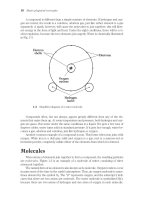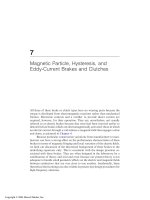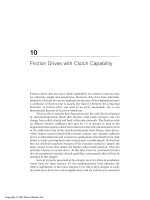Opportunistic Communication and Multiuser Diversity pdf
Bạn đang xem bản rút gọn của tài liệu. Xem và tải ngay bản đầy đủ của tài liệu tại đây (1.66 MB, 34 trang )
1
6: Opportunistic Communication and Multiuser
Diversity
Fundamentals of Wireless Communication, Tse&Viswanath
6. Opportunistic Communication and
Multiuser Diversity
2
6: Opportunistic Communication and Multiuser
Diversity
Fundamentals of Wireless Communication, Tse&Viswanath
Fundamental Feature of Wireless Channels:
Time Variation
•
multipath fading
•
large-scale channel variations
•
time-varying interference
3
6: Opportunistic Communication and Multiuser
Diversity
Fundamentals of Wireless Communication, Tse&Viswanath
Traditional Approach to
Wireless System Design
Compensates for channel fluctuations.
4
6: Opportunistic Communication and Multiuser
Diversity
Fundamentals of Wireless Communication, Tse&Viswanath
Example: CDMA Systems
Two main types of compensating mechanisms:
1. Channel diversity:
–
frequency diversity via Rake combining
–
time diversity via interleaving and coding
–
macro-diversity via soft handoff
–
transmit/receive antenna diversity
2. Interference management:
–
power control
–
interference averaging
5
6: Opportunistic Communication and Multiuser
Diversity
Fundamentals of Wireless Communication, Tse&Viswanath
What Drives this Approach?
Main application is voice, with very tight latency requirements.
Needs a consistent channel.
6
6: Opportunistic Communication and Multiuser
Diversity
Fundamentals of Wireless Communication, Tse&Viswanath
Opportunistic Communication:
A Different View
Transmit more when and where the channel is good.
Exploits fading to achieve higher long-term throughput, but no
guarantee that the "channel is always there".
Appropriate for data with non-real-time latency requirements (file
downloads, video streaming).
7
6: Opportunistic Communication and Multiuser
Diversity
Fundamentals of Wireless Communication, Tse&Viswanath
Point-to-Point Fading Channels
Capacity-achieving strategy is waterfilling over time.
8
6: Opportunistic Communication and Multiuser
Diversity
Fundamentals of Wireless Communication, Tse&Viswanath
Performance over Rayleigh Channel
9
6: Opportunistic Communication and Multiuser
Diversity
Fundamentals of Wireless Communication, Tse&Viswanath
Performance: Low SNR
At low SNR, capacity can be greater when there is fading.
10
6: Opportunistic Communication and Multiuser
Diversity
Fundamentals of Wireless Communication, Tse&Viswanath
Hitting the Peaks
At low SNR, one can transmit only when the channel is at its peak.
Primarily a power gain.
In practice, hard to realize such gains due to difficulty in tracking
the channel when transmitting so infrequently.
11
6: Opportunistic Communication and Multiuser
Diversity
Fundamentals of Wireless Communication, Tse&Viswanath
Multiuser Opportunistic Communication
12
6: Opportunistic Communication and Multiuser
Diversity
Fundamentals of Wireless Communication, Tse&Viswanath
Performance
Increase in spectral efficiency with number of user at all
SNR’s, not just low SNR.
AWGN
13
6: Opportunistic Communication and Multiuser
Diversity
Fundamentals of Wireless Communication, Tse&Viswanath
Multiuser Diversity
Total average SNR = 0 dB.
•
In a large system with users fading independently, there is likely to
be a user with a very good channel at any time.
•
Long term total throughput can be maximized by always serving
the user with the strongest channel.
14
6: Opportunistic Communication and Multiuser
Diversity
Fundamentals of Wireless Communication, Tse&Viswanath
Multiuser Diversity: A More Insightful Look
•
Independent fading makes it likely that users peak at different times.
•
In a wideband system with many users, each user operates at low
average SNR, effectively accessing the channel only when it is near
its peak.
•
In the downlink, channel tracking can be done via a strong pilot
amortized between all users.
15
6: Opportunistic Communication and Multiuser
Diversity
Fundamentals of Wireless Communication, Tse&Viswanath
Application to 1x EV-DO’s DownLink
•
Multiuser diversity provides a system-wide benefit.
•
Challenge is to share the benefit among the users in a
fair way.
16
6: Opportunistic Communication and Multiuser
Diversity
Fundamentals of Wireless Communication, Tse&Viswanath
Rate Control
Mobile measures the channel based on the pilot and predicts the
SINR to request a rate.
17
6: Opportunistic Communication and Multiuser
Diversity
Fundamentals of Wireless Communication, Tse&Viswanath
Symmetric Users
Serving the best user at each time is also fair in terms of
long term throughputs.
18
6: Opportunistic Communication and Multiuser
Diversity
Fundamentals of Wireless Communication, Tse&Viswanath
Asymmetric Users: Hitting the Peaks
Want to serve each user when it is at its peak.
A peak should be defined with respect to the latency time-scale t
c
of the application.
19
6: Opportunistic Communication and Multiuser
Diversity
Fundamentals of Wireless Communication, Tse&Viswanath
Proportional Fair Scheduler
Schedule the user with the highest ratio
R
k
= current requested rate of user k
T
k
= average thruput of user k in the past t
c
time slots.
20
6: Opportunistic Communication and Multiuser
Diversity
Fundamentals of Wireless Communication, Tse&Viswanath
Performance
Fixed environment: 2Hz Rician fading with E
fixed
/E
scattered
=5.
Low mobility environment: 3 km/hr, Rayleigh fading
High mobility environment: 120 km/hr, Rayleigh fading
21
6: Opportunistic Communication and Multiuser
Diversity
Fundamentals of Wireless Communication, Tse&Viswanath
Channel Dynamics
Channel varies faster and has more dynamic range in mobile
environments.
22
6: Opportunistic Communication and Multiuser
Diversity
Fundamentals of Wireless Communication, Tse&Viswanath
Why No Gain with High Mobility?
3 km/hr 30 km/hr 120 km/hr
Can only predict the average of the channel fluctuations,
not the instantaneous values.
23
6: Opportunistic Communication and Multiuser
Diversity
Fundamentals of Wireless Communication, Tse&Viswanath
Throughput of Scheduler: Asymmetric Users
(Jalali, Padovani and Pankaj 2000)
24
6: Opportunistic Communication and Multiuser
Diversity
Fundamentals of Wireless Communication, Tse&Viswanath
Inducing Randomness
•
Scheduling algorithm exploits the nature-given channel fluctuations
by hitting the peaks.
•
If there are not enough fluctuations, why not purposely induce
them?
25
6: Opportunistic Communication and Multiuser
Diversity
Fundamentals of Wireless Communication, Tse&Viswanath
Dumb Antennas
The information bearing signal at each of the transmit antenna
is multiplied by a random complex gain.









